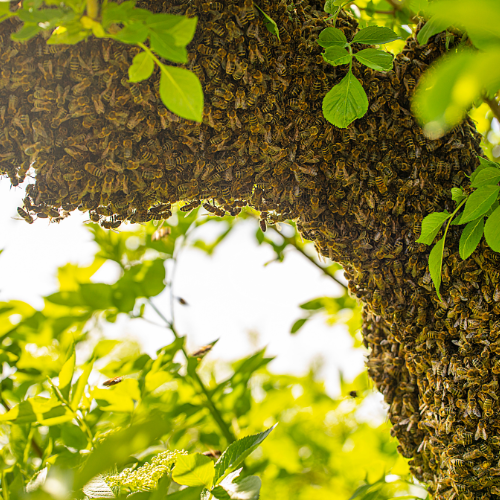
29 Feb Handling a Bee Swarm at Home
Strategy for Bee Swarm Situations
Bees play a crucial role in our ecosystem, but when they decide to swarm near your home, it can be a cause for concern. In South Florida, where bee activity is common, knowing how to safely handle a swarm is essential for homeowners.
Bees usually swarm when their colony becomes overcrowded, and they’re in search of a new home. This natural process is often mistaken for aggression, but swarming bees are generally non-aggressive. In our region, you might encounter various bee species, each with its own unique habits. Understanding these behaviors is key to managing a swarm situation effectively.
Swarming is a temporary phase, and bees often move on within a few days. However, if the swarm decides to settle on your property, it’s important to address the issue promptly. Identifying the type of bees and their intentions early on can help you determine the best course of action.
Spotting and Responding to Bee Swarms
Recognizing a bee swarm is the first step in dealing with it safely. A swarm typically appears as a large cluster of bees hanging from a tree branch, fence, or other structure. Unlike regular bee activity around flowers, a swarm is more concentrated and may seem intimidating.
If you spot a swarm, observe from a safe distance. Look for signs of the bees establishing a more permanent nest, such as bees entering a hole in your home’s exterior. Quick identification can prevent the swarm from becoming a more challenging infestation.
Taking photos or videos of the swarm from a safe distance can be helpful for identification purposes. Share these with pest control professionals to determine the best course of action. Accurate identification is crucial for effective and safe removal.
Family and Pet Safety
The safety of your family and pets is paramount during a bee swarm situation. Maintain a safe distance from the swarm to avoid provoking the bees. Sudden movements or attempts to remove the swarm yourself can lead to stings or a more aggressive response.
Protecting vulnerable individuals, especially those with bee allergies, is crucial. Ensure that children and pets are kept indoors, and inform family members and neighbors about the swarm. If anyone is allergic to bee stings, have an emergency plan in place.
In case of a bee sting, it’s important to know how to treat it. Remove the stinger gently, clean the area, and apply a cold compress to reduce swelling. Monitor for any signs of an allergic reaction and seek medical attention if necessary.
Bees with Professional Intervention
Professional intervention is often necessary to safely remove a bee swarm. Experts like Pest Busterzz have the knowledge and equipment to relocate the swarm without harming the bees or putting residents at risk. Our team is trained to handle various bee species and can provide a solution that respects both your safety and the bees’ well-being.
Attempting DIY removal can be dangerous and is generally not recommended. Contacting professionals ensures that the swarm is handled responsibly and that the bees can continue their vital role in the ecosystem elsewhere.
Choosing a pest control company with experience in bee relocation is crucial. Look for professionals who prioritize humane methods and bee conservation. By selecting the right experts, you can ensure the safety of your home and contribute to the protection of these important pollinators.
Minimizing Bee Swarm Risks
To reduce the likelihood of future bee swarms, take proactive steps to make your property less attractive to bees. Seal potential entry points in your home’s exterior, such as cracks and crevices, to prevent bees from nesting. Regular property maintenance, including trimming vegetation and removing debris, can also deter bees from settling near your home.
Regular inspections by pest control professionals can help detect early signs of bee activity. Early intervention can prevent a small swarm from becoming a larger problem. By staying vigilant and addressing issues promptly, you can minimize the chances of experiencing a bee swarm on your property.
Additionally, consider installing bee-friendly features in your garden, such as bee houses, to provide alternative nesting sites. Planting flowers that attract bees away from your home can also help. By creating a welcoming environment for bees in a designated area, you can enjoy their benefits without the risk of a swarm near your living spaces.
Conclusion
In conclusion, effectively managing a bee swarm situation requires a combination of understanding, caution, and professional assistance. By recognizing the signs of a swarm and maintaining a safe distance, homeowners can protect their families and pets from potential harm. It’s important to respect the natural behavior of bees and seek expert help when necessary.
Proactive measures can significantly reduce the chances of future swarms. Regular home maintenance, sealing entry points, and creating a bee-friendly environment are key steps in preventing unwanted bee activity. Consulting with pest control professionals for regular inspections can also help in early detection and management of potential swarms.
Ultimately, bees are a vital part of our ecosystem, and their preservation is essential. By adopting responsible practices and working with professionals like Pest Busterzz, homeowners can ensure the safety of their homes while contributing to the well-being of these important pollinators. Remember, coexisting with nature and protecting our environment starts with informed and mindful actions.


No Comments